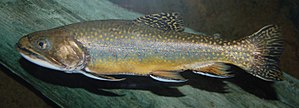Brook trout
| Brook trout | ||||||||||||
|---|---|---|---|---|---|---|---|---|---|---|---|---|

Brook trout |
||||||||||||
| Systematics | ||||||||||||
|
||||||||||||
| Scientific name | ||||||||||||
| Salvelinus fontinalis | ||||||||||||
| ( Mitchill , 1814) |
The brook trout ( Salvelinus fontinalis ) belongs to the salmonid family ( salmon fish ). In 1884 it was introduced from North America (called Brook Trout or Northern Brook Trout there).
features
The average size in freedom ( Europe ) is rarely more than 35, a maximum of 55 centimeters. The fish usually does not weigh more than a kilogram. The characteristics of the water and the amount of food are decisive for the growth of the char . The North American char can weigh up to four kilograms. The maximum age under natural conditions is eight to ten years. The brook trout is a popular fish in aquaculture and is usually preferred to the rainbow trout in culinary terms.
The char is considered to be one of the most beautiful and colorful representatives of the salmonids. The colors change from population to population. Its body shape is typically torpedo-shaped. Like all salmonids, the char also has an adipose fin . The ventral fins have a striking red-orange colored border with a white border. Characteristic is the narrow black border between this white border and the red of the fins. The back is colored brown and marbled olive. Brook trout have small scales and a large mouth opening.
distribution and habitat
The brook trout lives in cold and oxygen-rich, both flowing and standing waters (such as mountain lakes). It colonizes the waters of Iceland, Europe, Asia and North America.
Way of life
The char hardly needs any shelters and is therefore, due to its extremely wide food spectrum, also suitable for colonizing straightened and rapidly flowing streams and, above all, for stocking the source regions of our mountain streams. But since it does not belong to the native species, it should not be stocked with this species in order not to disturb the existing ecosystems . It is more tolerant of low pH values than the native brown trout . The sterile tiger trout , which owe their name to the striking golden-yellow markings, arise from the cross between brook trout and brown trout . The brook trout is one of the gravel spawners, whereby the Rogner create a spawning pit by twisting the abdomen and also swirling up the ground sludge with the tail fin before they begin to eject the eggs.
The food mainly consists of plankton crabs and soil organisms. In the summer, approach food often plays, such as B. Locusts , a role. Larger brook trout also feed on fish (including their own species).
Systematics
In addition to the brook trout, there are other types of char: the American lake trout ( Salvelinus namaycush ), the lake char ( Salvelinus alpinus ) as well as numerous local forms (e.g. Schwarzreuter). The Alsatian char is a cross between brook char and arctic char.
literature
- Fritz Terofal: Freshwater fish in European waters. With 200 color illustrations by Fritz Wendler. Mosaik Verlag et al., Munich et al. 1984, ISBN 3-570-01274-3 .
- Alexander Kölbing, Kurt Seifert: This is how fishing is fun. Know more - catch more. 5th revised edition. BLV, Munich et al. 1995, ISBN 3-405-13746-2 .
- Roland Gerstmeier, Thomas Romig: The freshwater fish of Europe. For nature lovers and anglers. Kosmos, Stuttgart 1998, ISBN 3-440-07068-9 .
Web links
- Brook trout on Fishbase.org (English)
- More information about brook trout
